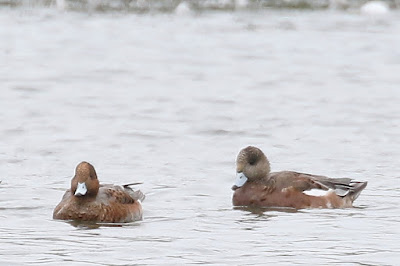It's been three years since I made it to Shetland after a planned trip last year was cancelled due to the constraints of the pandemic, so this year's visit was awaited with great anticipation by the whole team. This consisted of driver and organiser-in-chief David Bradnum, RSPB Rainham stalwart Howard Vaughan and 'Wanstead Birder' Jonathan Lethbridge who we were due to pick up in Fife on day two. Bob Vaughan, the 4th member of the team from my previous two visits was sadly absent on this occasion (we missed you, Bob).
 |
| American Wigeon (right) with Eurasian Wigeon |
Shetland by bike would have taken more time and energy than I possess, so the low-carbon birding theme of the year was suspended temporarily as I drove up to Huntingdon on Thursday 30th September to meet David and Howard en route. With luggage and optics safely transferred to the capacious boot of Bradders's Volvo, we were away and the first rarity of the trip was soon under the belt with an American Wigeon picked out from several hundred of its close relatives at a Cambridgeshire gravel pit.
 |
| American Wigeon (right) |
Next stop was Blacktoft Sands where Howard was instantly recognised by the volunteer warden - an occupational hazard for a popular and long-serving member of RSPB staff. Our target species - a White-tailed Lapwing present for several weeks - was the nearest, indeed the only, bird on the pool outside the First Hide, and also the first 'mega' rarity of the week-and-a-bit which lay ahead.
 |
| White-tailed Lapwing, Blacktoft Sands |
This was already starting to feel too easy so for our next stop we decided to up the difficulty level and stop at Druridge Pools on the Northumberland coast, a familiar spot thanks to my August family holiday in the area earlier this year. Viewing the pools is not easy so it wasn't a total surprise that we couldn't find our target species - a Pectoral Sandpiper - but the spectacle of large flocks of Pink-footed Geese wheeling over the dunes was a delight to three southereners who rarely get to experience such a thing in our home counties.
 |
| White-tailed Lapwing, Blacktoft Sands |
There was time for a quick look at the sea before heading for our first overnight stop at Wooler, and Druridge Bay held 20+ Red-throated Divers and several flocks of Common Scoter. Scanning with my dinky MM4 scope I went past a diver which merited a second look as it had the uptilted bill of a Red-throated Diver but the bulk and colouration of a winter-plumaged Great Northern Diver. I shouted to the others to have a look at it and confirm my suspicions that it was a GND and they replied in the affirmative. I continued to scan and a few minutes later the guys hailed me in a way which suggested they were looking at something interesting.
They had continued to watch the diver and were now leaning towards re-identification as White-billed, a much rarer species. It was distant but the features seemed to add up so we put the news out as a 'probable' in the hope of giving at least the locals the chance to get there before dark. Shortly after David and Howard picked up a couple of regular Great Northern Divers which made them even more confident that the earlier tentative identification was correct.
 |
| Pink-footed Geese, Druridge Pools |
We had lost sight of the White-billed by the time the first locals arrived, and headed for the well-appointed hostel at Wooler booked in advance with typical efficiency by Bradders Birding Tours Ltd. (Don't google that BTW hoping to make a booking, as it doesn't actually exist - it's just our affectionate tribute to our driver's phenomenal logistical abilities, which generally involve him sorting ferries, accommodation etc whilst we merely wire occasional tranches of cash to his account).
The leisurely journey north split over two days has become a deliberate part of BBT's Shetland strategy, allowing any east coast goodies to be swept up on the way to Aberdeen, and thus far it seemed to be paying off. But what would day two bring?


No comments:
Post a Comment